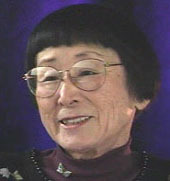
|
||
 Enlarge
Enlarge
|
Licensing | |
To view video, Click Here. Kay M. shares her memories of Gila River and getting used to the insects and dust in her barrack.
"Well there was, Camp One and Camp Two were similar. I mean, they were all barracks you know. Black tar paper on the wall, but then, some people said their ground, their floors were ground. But we had wood. But when we first went in there it wasn't a tight fit. And when the wind blows, or -- and we had lot of scorpions and Gila monsters and things like that come in. And some people, we've never had it in our bed, but they said they opened their bed and there was scorpions in there. And then I heard some people got bit, but I don't know anybody personally that got bit, it was just hearsay here again. But anyway, we would get up in the morning and clean up all our what little furniture we -- all our furniture was made by scrap lumber. And my husband, being a carpenter, he made me little vanity set and a little bench and things to make it look homey. But it was just white with dust. Because up there and down in there was -- and as we stayed the first winter, now it was cold, because whenever the wind blew through the cracks came in."
Kay M. Interview - Copyright © 1999 Densho. All Rights Reserved.
Nisei female. Born April 17, 1917 in Moneta, California. Grew up working on family's strawberry farm. Attended Japanese language school where she learned Japanese dancing and singing. Was popular and excelled in high school, but was prevented by the Parent Teacher Association from giving the commencement address because of her ethnicity. Attended dress design school, and opened a dressmaking shop at the age of twenty-one. Met her husband through a Japanese matchmaker and got married soon after the onset of WWII in anticipation of being incarcerated. Was incarcerated at the Gila River incarceration camp where her husband contracted tuberculosis. Cared for ailing husband, who was isolated and confined to the camp hospital. Taught incarcerees dressmaking as well as Japanese dancing and singing. Converted to Christianity as a result of weekly visits by Christian missionaries to the camp. After the war ended and the camp was nearly empty, went into a prolonged and difficult labor, requiring that the staff reopen the hospital and she and her husband stay at Gila River after everyone else had left. Resettled in Fresno, California.
Courtesy of Densho: The Japanese American Legacy Project
 densho
—
Atualizado em Out 29 2019 3:16 p.m.
densho
—
Atualizado em Out 29 2019 3:16 p.m.
Part of these albums

|
Voices from the Camps densho
densho
|

|

 Voices from the Camps
Voices from the Camps
 Journal feed
Journal feed
